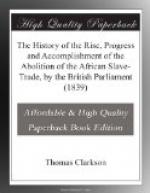CHAPTER VI.
[Sidenote: Observations on the three classes already introduced.—Coincidence of extraordinary circumstances.—Individuals in each of these classes, who seem to have had an education as it were to qualify them for promoting the cause of the abolition; Sharp and Ramsay in the first; Dillwyn in the second; Pemberton and Rush in the third.—These, with their respective classes, acted on motives of their own, and independently of each other; and yet, from circumstances neither foreseen nor known by them, they were in the way of being easily united in 1787.—William Dillwyn, the great medium of connexion between them all.]
If the reader will refer to his recollection, he will find that I have given the history of three of the classes of the forerunners and coadjutors in the great cause of the abolition of the Slave Trade up to the time proposed. He will of course expect that I should proceed with the history of the fourth. But, as I foresee that, by making certain observations upon the classes already introduced in the present, rather than in any future, place, I shall be able to give him clearer views on the subject, I shall postpone the history of the remaining class to the next chapter.
The account which I shall now give, will exhibit a concurrence of extraordinary and important circumstances. It will show, first, that in each of the three classes now introduced, there were individuals, in the year 1787, who had been educated as it were for the purpose of becoming peculiarly qualified to act together for the promotion of the abolition of the Slave Trade. It will show, secondly, that these, with their respective classes, acted upon their own principles, distinctly and independently of each other. And lastly, that by means of circumstances, which they themselves had neither foreseen nor contrived, a junction between them was rendered easily practicable, and that it was beginning to take place at the period assigned.
The first class of forerunners and coadjutors consisted principally, as it has appeared, of persons in England of various descriptions. These, I may observe, had no communication with each other as to any plan for the abolition of the Slave Trade. There were two individuals, however, among them who were more conspicuous than the rest, namely, Granville Sharp, the first labourer, and Mr. Ramsay, the first controversial writer, in the cause.
That Granville Sharp received an education as if to become qualified to unite with others, in the year 1787, for this important object, must have, appeared from the history of his labours, as detailed in several of the preceding pages. The same may be said of Mr. Ramsay; for it has already appeared that he lived in the island of St. Christopher, where he made his observations, and studied the laws, relative to the treatment of slaves, for nineteen years.




